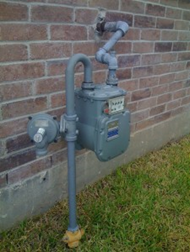Pipeline leaks can be dangerous. Damage to pipelines, most often caused by excavation, occurs too frequently to low pressure distribution lines, but is rare along gathering and transmission lines. A damaged pipeline may release flammable products into the soil or the air that can be harmful to people and the environment. It is important that you know how to quickly respond to a potential pipeline emergency.
Use your sense of smell, sight and sound to identify a potential pipeline leak. Signs of a leak may include:
- • SMELL: Strong petroleum scent or other pungent odor, a smell similar to rotten eggs, or sulfur, if odorant is added
- • SIGHT: Dead or dying vegetation near the pipeline, pools of liquid or fire on the ground near the pipeline, dirt or debris blowing into the air, fire or a dense white cloud or fog
- • SOUND: Hissing, gurgling or roaring sound near pipelines or pipeline markers

If your home or business uses gas appliances, these appliances are connected to a pipeline that delivers natural gas. Natural gas is odorless, so we add an odorant, called Mercaptan, to help detect a leak. If you smell something similar to sulfur or rotten eggs, it may indicate a gas leak.
If you suspect a gas leak inside your home or business:
- 1. Leave the building immediately.
- 2. As you leave, do not use electronic devices, including light switches or garage door openers. Never use a cellular or land line phone in the vicinity of a potential leak. Even the tiniest spark can ignite the gas.
- 3. From a safe location, call 911 and your local gas company.
If you have gas appliances or other fuel-burning appliances in your home, consider creating an emergency contact list that includes the emergency number for your local gas company. For more information about how to create an emergency contact list or emergency plan for your home or business, visit www.ready.gov.
Also consider installing a carbon monoxide detector to monitor and prevent carbon monoxide poisoning. Visit the Centers for Disease Control and Prevention to learn more about what you can do to prevent carbon monoxide poisoning.
IF YOU SUSPECT A LEAK NEAR A PIPELINE RIGHT-OF-WAY, METER OR ABOVEGROUND FACILITY
If you suspect a problem with a pipeline or aboveground facility, including gas meters, outside your home or business, leave the area immediately in an upwind direction. From a safe location, call 911 and the pipeline operator. Do not operate vehicles, mechanical equipment, cell phones, electronic devices or any item that could create a spark near a suspected leak. Do not light a match or cigarette. Avoid contact with liquids or gases coming from the pipeline. If you live or work near a pipeline, make sure that the pipeline operator’s name and emergency number are included in your emergency contact list. Make note of permanent pipeline markers located along the general route of the pipeline. Pipeline markers generally include the operator’s name, emergency number and a description of the product transported.
